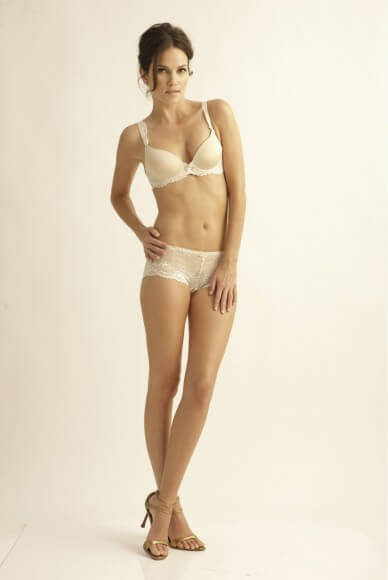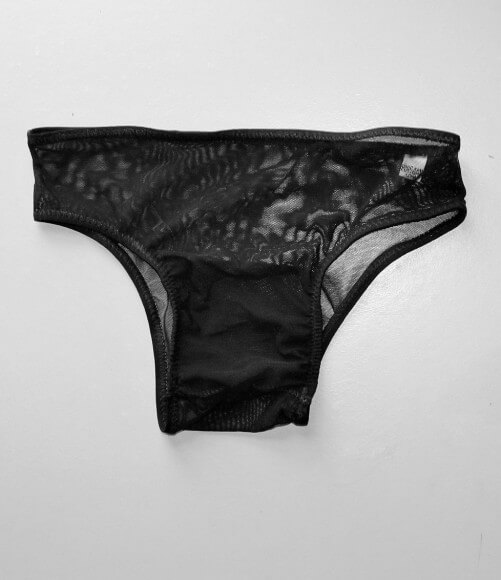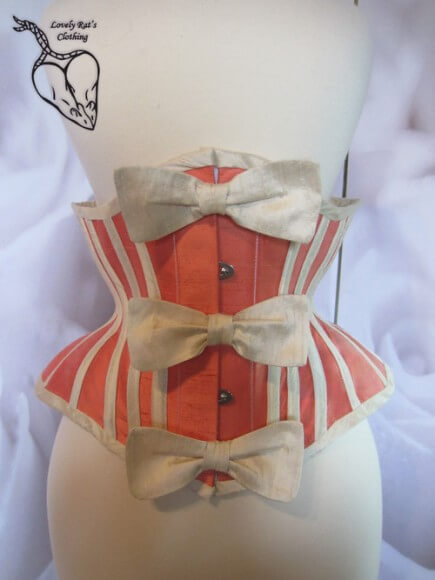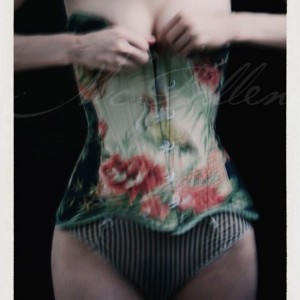Lingerie Shopping for Trans Women
Disclosure: this post contains affiliate links.
Editor's Note: This article is part of an ongoing series on trans concerns and lingerie. For more, see our guides to Swimwear for Trans Women and Swimwear for Trans Men.
So you’re a trans woman, and you'd like to buy some lingerie. As I’ve mentioned before, lingerie shopping for trans women can be fraught: finding retailers who sell your band/cup size, working with companies that respect and appreciate you, figuring out what size you are, etc. So I’m going to do a rundown of the basics of lingerie, as well as hook you up with some guides that others have written. Let’s talk lingerie fit basics, shall we?
One of the first things you’ll need to do is take your measurements. If you’re going to be doing a lot of lingerie shopping in a short period of time, I’d suggest writing them down on a card and keeping it in your wallet. Knowing your measurements is an armor against all the opaque sizing conventions of the lingerie world: no matter what size you are at a specific retailer, your measurements will remain the same.
You'll need to know, at minimum, the following: your underbust, which is where your bra band sits, right under your breasts. Your bust, or the widest part of your chest; your waist, which is where your body naturally creases in half (if you're having trouble discerning it, bending to the side and finding the crease may help), and finally, your lower and/or upper hip. Upper hip is sort of like waist in guy pants: it's where your hipbones start. Lower hip is the fullest part of your butt and is generally what you use to measure for panties. You may also occasionally need a measurement of your thigh circumference or your torso length. See my very helpful diagram below.
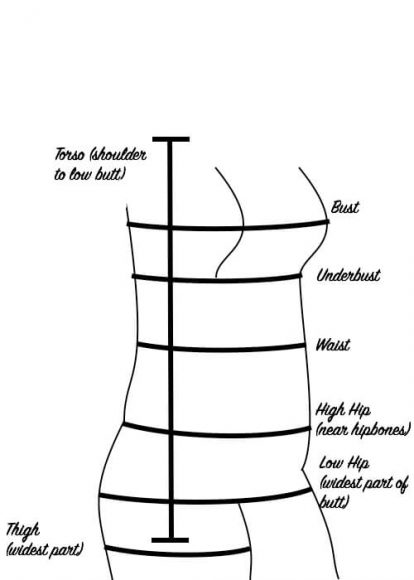
You may want to know both "high hip" and "low hip", but I feel the larger of the two measurements has the bigger impact on fit.
Your measurements are a tool - nothing more, nothing less. Don’t beat yourself up about them, whatever they are. You look hot, I promise. You’ll look even hotter in lingerie that you love. Once you have your measurements, you can use them to fit yourself for garments you’re buying, or to tell any salespeople or friends who may be helping you look. You may need some additional measurements for more complicated garments, but let’s start with something many girls want at some point: a good bra.
How to Fit Yourself for a Bra
The first thing you’ll need to understand is: bra fitting is absurd, and is calculated using an equal mixture of math and wizardry. For example: bra fit is/was supposed to originally work like this: you measured your underbust (the area right under your bust) in inches. Then you measured your bust in inches. Then your underbust plus four was your band size, and your cup size was based on a direct scaling up from that number: one inch of size difference was an A, two was a B, etc. But it’s more complicated than that now.
Using a calculator program designed by herroom.com, I put myself to the test. My underbust, in inches, is 32. My bust, in inches, is 38. Somehow the bra calculator thing turned that into a 34D. I think that has something to do with band size not being the same as underbust size, but it’s a little arcane. Generally to get your band size you start with your underbust measurement and add either 0, 2, or 4 to that number. Since trans women tend to have wider ribcages but also less squish to the upper torso, you'll probably want to go larger in the band to get the most comfortable fit. If you're struggling to find your size, bra extenders are a thing that exist.
Once you know the ballpark of your size, I’d suggest trying bras either a little larger or smaller in both cup and band until you find your personal best fit. Even though I’m “supposed” to be a 34D, what I actually enjoy wearing is a 34C. Especially in larger band sizes, there can be a lot of variance between what your calculated size is and how a bra will actually fit --- because of sizing standards, different bra materials, construction techniques, you get the idea.
If you have a larger ribcage size, you may also be more able to find bras in your band size if they’re larger in the cup as well, since companies still assume plus-sized women will have larger breasts. In that case, you might want to try filling out the cup with bra inserts to see if you like the look. If you need a large band and a small cup, try this list for a few online retailers.
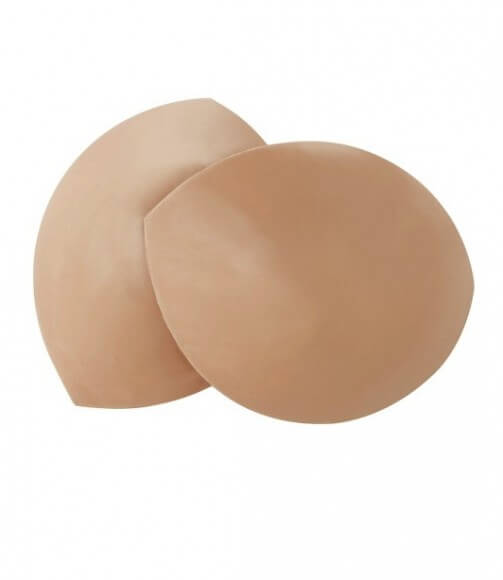
Bra inserts recommended on Autostraddle. Via Target.
Autostraddle has a great guide to finding bra shapes and bra styles that suit trans women, and I highly suggest you check it out. In addition, lingerie designer Rachel Hill of Origami Customs suggests looking for bras with longer straps.
A word of advice: you find an everyday bra you love, something that makes you look and feel good --- buy two or three. I lost my favorite bra to discontinuation in 2008 and it crushed me to watch the one I had left wear out. This advice may not be applicable if your breast size is changing on the regular, but once it slows down a little: backup bras. I can’t emphasize how much brands love to discontinue your favorites. It’s uncanny.
How to Fit Yourself for Panties
Panty fit doesn’t get talked about a lot, but I think that it’s important. Panties that dig into your upper hip are the worst. Panties that are too small will mush your lower hip down, leaving you buttless. But panties that are too big bunch up in ways you would never anticipate. There’s an excellent panty fitting guide available here, and it contains a handy chart that can tell you what size you are.
If you’re buying panties in a pack, refer directly to what the pack says is the size for your measurements, since pack underwear often has its own size standards. If you’re between sizes, or your measurements don’t correlate neatly to the chart, I suggest sizing up. Cotton panties especially have a tendency to shrink in the wash.
If you’re looking to tuck, which you may not be, you may have success with either high-waisted panties, shapewear, or gaffs (panties designed specifically to help a tuck). Rachel Hill suggests mesh or Lycra for a tight tuck and cotton or bamboo for a more comfortable fit. All of the above are more advisable than doubling up on underwear, buying underwear that's too small, or (god forbid) using tape. Don’t crush your stuff; buy a garment that’s designed to help you out.
How to Fit Yourself for Other Pieces
There is so much more to lingerie than bras and panties. Bodysuits, camisoles, slips, corsetry, tank tops that are also dresses that also clip onto garters... you get the idea. Lingerie is an amazing opportunity to explore different modes of femininity, and if you can afford it, it’s worth doing some experimenting with different styles that you might like.
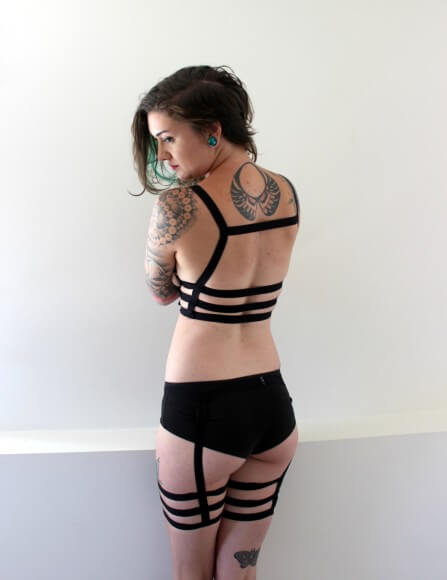
You'll need to measure your thigh circumference for best fit, but think how cute you'd look in this. Via Origami Customs.
The more unusual or novel your lingerie is, the more difficult it will be to anticipate fit. Therefore, if you’re buying something like a latex bodysuit (something expensive and unyielding), I suggest trying it on in person or getting it custom fitted. If you’re buying something with stretch to it, or if you’re buying throwaway pieces for fun, online is a much more plausible solution.
There are, of course, some online retailers that are trans friendly and may be willing to help you with custom fits. Lovely Rats does custom corsetry and is pro-trans. Origami Customs specializes in customizing lingerie for trans bodies. And many Etsy shops will all give you some leeway in getting a custom fit since the sellers are already making the pieces by hand. Here, referring back to your measurements will help you immensely.
You may also need to take additional measurements for more complex pieces. For anything that is bodysuit-ish, for example, you’ll either want to check that it is adjustable at the shoulder, or measure your torso from shoulder to the base of your rear and make sure the garment is going to bridge that distance without adjustment. If you’re buying a slip meant to go under a dress, you’ll want to make sure the total length of the slip is shorter than the dress. And so on.
That’s all for today. Soon we’ll be talking a bit about trans-friendly retailers, both online and in person.
Trans women: what are your tips for fitting lingerie? Let us know in the comments!





